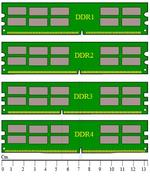RAM vs ROM: Static RAM vs Dynamic RAM Explained
Advertisement
This page covers the difference between RAM and ROM. It also covers the difference between static RAM and Dynamic RAM. Memories are of two types: primary and secondary.
RAM and ROM are types of primary memory.
Semi-random and serial access are types of secondary memory. Examples of semi-random memories include all disc memories such as CDs, DVDs, etc.
Examples of serial access memories include magnetic tape, magnetic bubble ferrite core, CCD, etc.
RAM vs. ROM
| Feature | RAM (Random Access Memory) | ROM (Read-Only Memory) |
|---|---|---|
| Access | Read/Write memory | Read-only memory |
| Volatility | Volatile memory (used for temporary data storage) | Non-volatile memory (used for permanent data storage) |
| Purpose | Stores data and instructions currently being used by the CPU | Stores boot instructions and firmware |
Static RAM vs. Dynamic RAM
| Feature | Static RAM (SRAM) | Dynamic RAM (DRAM) |
|---|---|---|
| Data Storage | Data is stored like a flip-flop (FF) | Data is stored in a MOS capacitor |
| Transistor Type | BJT, MOSFET is used | MOSFET is used |
| Speed | Faster operation | Slower operation |
| Power Dissipation | Higher power dissipation | Lower power dissipation |
| Density | Lower density | Higher density |
| Usage | Used as cache memory | Used as main memory |
| Refreshing | No refreshing needed | Refreshing is needed |
Advertisement
 RF
RF





